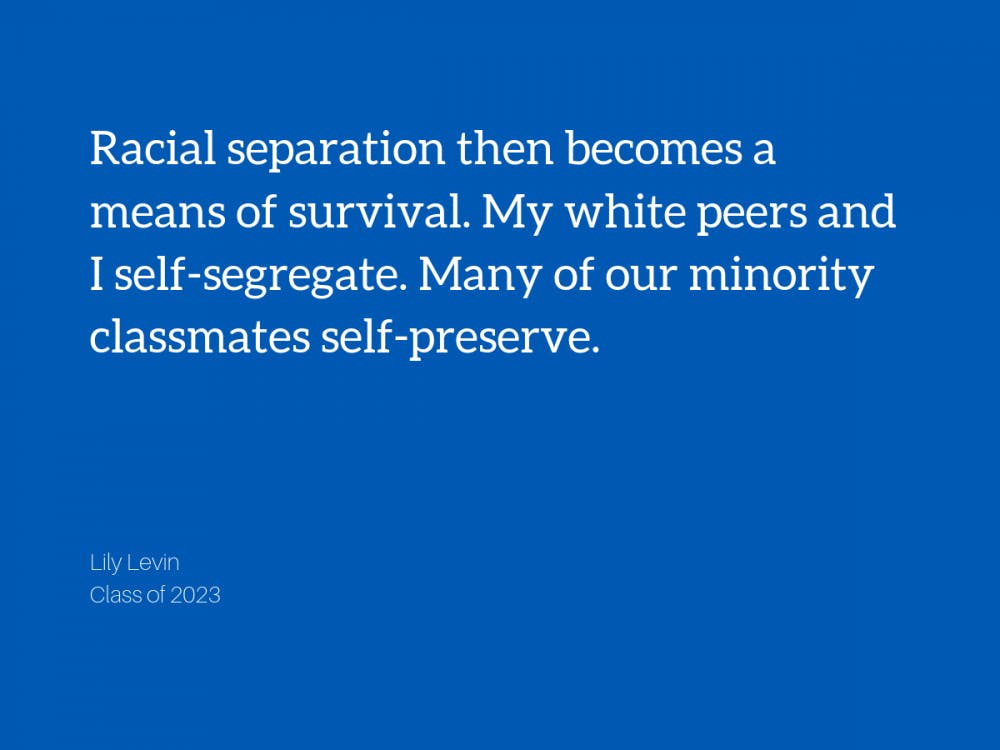College application season is near-approaching, and Duke has been forced to keep up: the admissions website appears to be more enticing than ever. In one image, a group of racially diverse students sits in front of Baldwin Auditorium accompanied by the heading, “This is Duke.”
However, after a mere few days as a student at this institution, I know that ‘this’ – whatever ‘this’ is— is not Duke. The diverse groups of students sitting in front of Baldwin were nowhere to be found (the presence of anyone in front of Baldwin is nonexistent, but that’s another story). The diverse groups of students anywhere on campus were, indeed, nowhere to be found.
So, as a first-year ingrained with the Duke Difference philosophy, with my knowledge of my own whiteness, I tasked myself with answering the number one question racing through my mind: why is our school so socially separated by race?
First, I did a bit of digging. Some in the form of online research, some through interpersonal relationships, some within myself.
The online avenue became a rabbit-hole of click after click after click. Click. Duke has yet to acknowledge its direct ties to slavery or to uplift the Black people who worked to build this university. Click. Duke deliberately supported the destruction of Crest Street, a historically Black community, while arguing that it had no control over the outcomes of the neighborhood. Click. Duke has yet to remove Executive Vice President Tallman Trask III, who in 2014 hit a parking attendant with his Porsche and allegedly used the n-word toward her, from office. From the wealth of information I’d gathered through Google searches, I learned the extent to which Duke is centered around whiteness, around white supremacy.
But, I thought to myself, this still doesn’t answer the question of racial stratification. I sat for a few moments with my thoughts and my feelings and my unanswered inquiries. And then I realized: all that is manufactured and commodified at the institutional level is mirrored, in some way, by the consumer. We, as white students, are the consumers of this rhetoric, of these unchallenged realities, of our own comfortable existence. Duke’s failure to hire more than twenty-five percent faculty of Color is to blame. Tallman Trask III is unequivocally at fault. But we bear no less of the responsibility.
There must be closed spaces in which students of color are comfortable expressing and communicating shared narratives that classmates not adhering to their specific racial group cannot understand. Race shapes socialization, which shapes life experiences. But when campus culture—whether interpersonally or systemically or both—deems whiteness superior, for some students of color, closed spaces feel like the only nonviolent spaces to exist. Racial separation then becomes a means of survival. My white peers and I self-segregate. Many of our minority classmates self-preserve.
Duke has attempted to somewhat alleviate this disparity through random first-year roommate assignment. This policy has received overwhelmingly positive feedback and is cited as a method of increasing student awareness of the wide range of identities at the university. Although this initiative undoubtedly has benefits--I met one of my current best friends through random assignment--it is a continuation of historic double-standard legislation. Many people of color have put in emotional labor throughout their entire lives to appease white people. It is only us, the white students at Duke, who are truly “educated” by a roommate of a diverse ethnic background. And our roommate, while being a source of this education, is perhaps forced to accept microaggressions and prejudice in their living space.
This column is not the first time someone has voiced these thoughts. Countless nonwhite students have been articulating the importance of safe spaces and the prevalence of racism on campus long before I began drafting this piece. But I write all of the above knowing that it is important for white students to acknowledge our own flawed preconceptions. I write all of the above knowing that I am not perfect. Knowing that I have made and will continue to make so many mistakes. But knowing that it is my duty to use my privilege to speak out.
White students: I am calling on us to change. I am calling on us to understand that we are responsible for educating ourselves—for understanding the homogenous spaces we’ve created. We can listen to our BIPOC peers, rather than speaking over them. We can task ourselves with being intentional about making friends of diverse backgrounds while also being aware of the danger of tokenization. We can call out and/or call in our white peers when we bear witness to an injustice. And we must also know that we are not the owners of allyship; we do not get to define what it entails.
Although nearly half its population is comprised of students of color, Duke is not be the utopia of diversity boasted on the admissions website. And I cannot, in good faith, call for the social integration of Duke if this forced mingling only benefits white students; if students of color are burdened with assimilating into white space. White students truly dedicated to reducing this racial stratification can begin by evaluating ourselves—how we interact with our nonwhite peers, our implicit biases and prejudices, and our actions (and inaction) around those who look like us.
This is Duke. ‘This’ is racial injustice. ‘This’ is white supremacy.
To white students and faculty at Duke, to our current administration, to our unacknowledged history, I ask one final question: is ‘this’ who we want to be?
Lily Levin is a Trinity first-year. Her column, “over-caffeinated convictions,” runs on alternate Fridays.
Get The Chronicle straight to your inbox
Signup for our weekly newsletter. Cancel at any time.

